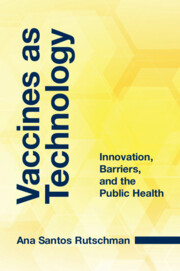Book contents
- Vaccines as Technology
- Vaccines as Technology
- Copyright page
- Contents
- Figures
- Acknowledgments
- Introduction
- 1 Vaccines as Instruments of Public Health
- 2 The Vaccine Development Ecosystem
- 3 Vaccine Development under Proprietary Paradigms
- 4 Access to Vaccine Technology
- 5 Aligning Vaccine Innovation with Public Health Needs
- 6 Vaccines of the Future
- Conclusion
- Index
1 - Vaccines as Instruments of Public Health
Published online by Cambridge University Press: 07 April 2022
- Vaccines as Technology
- Vaccines as Technology
- Copyright page
- Contents
- Figures
- Acknowledgments
- Introduction
- 1 Vaccines as Instruments of Public Health
- 2 The Vaccine Development Ecosystem
- 3 Vaccine Development under Proprietary Paradigms
- 4 Access to Vaccine Technology
- 5 Aligning Vaccine Innovation with Public Health Needs
- 6 Vaccines of the Future
- Conclusion
- Index
Summary
Pathogens and humans have coexisted for a long time. Studies suggest that, even before recorded history, nomadic populations are likely to have suffered from a plethora of diseases, such as malaria and perhaps yellow fever. The transition to a sedentary lifestyle anchored around small villages, and later on the establishment of large urban centers from Mesopotamia to the Indus Valley and what is modern-day China, paved the way for the increased spread and diversification of these pathogens. High population density, the comingling of humans and animals, and the proliferation of trade routes linking once-distant urban areas enabled viruses, bacteria, and other pathogens to propagate quickly and travel progressively farther. To this day, these dynamics set forth in antiquity continue to play out in similar ways in a world that has become more connected and densely populated.
- Type
- Chapter
- Information
- Vaccines as TechnologyInnovation, Barriers, and the Public Health, pp. 12 - 25Publisher: Cambridge University PressPrint publication year: 2022

